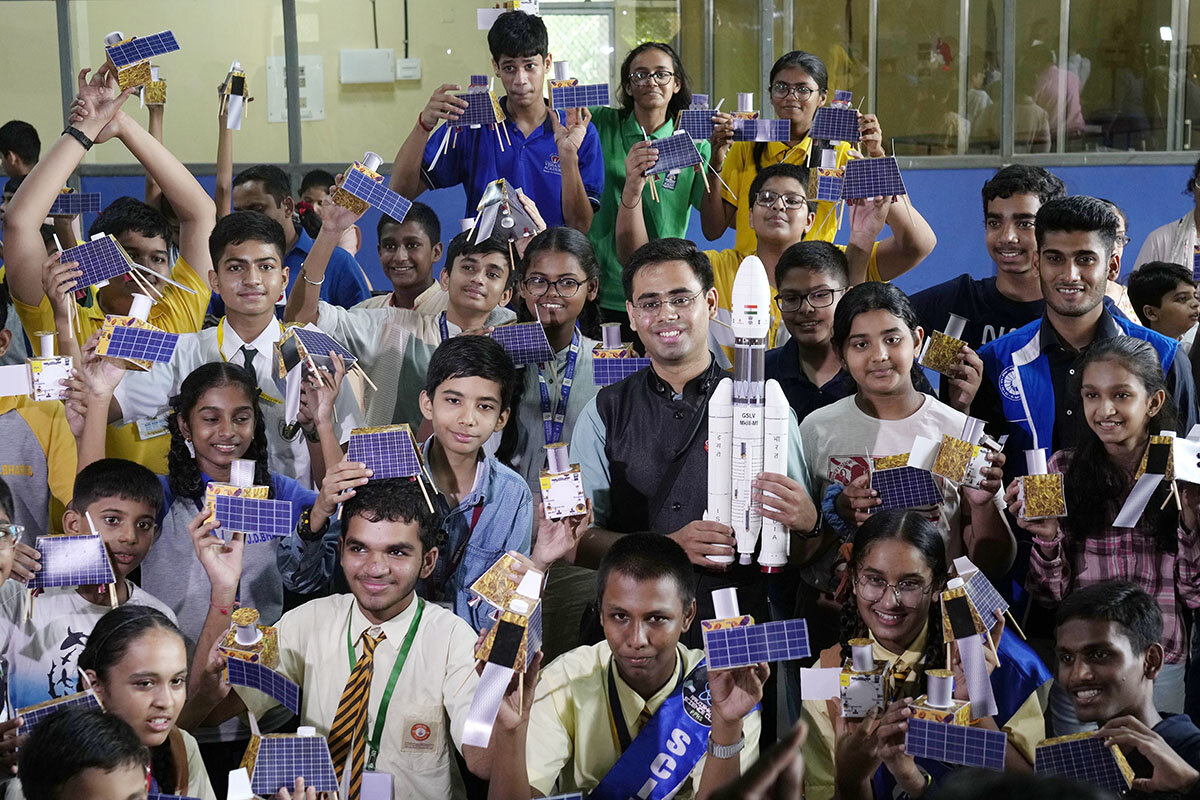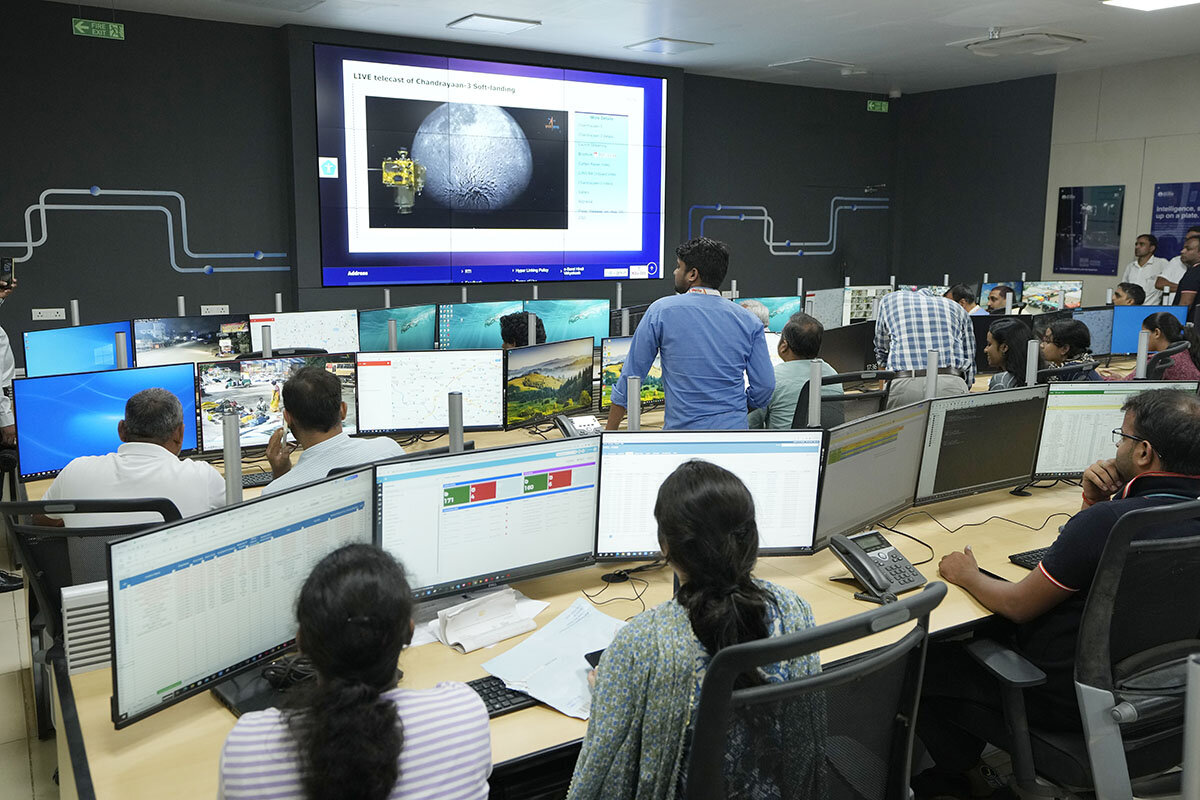How India won the race to the moon’s south pole
Loading...
| New Delhi
The scientists were glued to their screens, as were millions of others tuning in at home. All watched anxiously as the spacecraft’s four silver feet touched down.
“India is on the moon,” declared Sreedhara Somanath, the chief of the Indian Space Research Organization, as the control room in the southern Indian city of Bengaluru erupted in cheers.
It was a moment the whole nation had been waiting for. By becoming one of the few countries to land on the moon – and the first to do so near its south pole – India has proved its capacity for technological innovation and cemented itself as a space power.
Why We Wrote This
A story focused onLanding the Chandrayaan-3 spacecraft near the moon’s strategically important south pole is a major milestone for India’s evolving space program, demonstrating what can be achieved with modest resources.
“This moment is an invocation of India’s rising destiny,” Prime Minister Narendra Modi said moments after the landing. “This moment is a victory cry for a new India.”
The United States, China, and the former Soviet Union have landed on the moon before, but not near this critical area for future manned missions. Russia almost beat India to the moon’s south pole, but its Luna 25 spacecraft crashed on August 20.
The landing is not only a triumph for India’s scrappy space program, but also, observers note, a testament to what can be achieved with enough ingenuity and perseverance. India’s quest for the moon reflects the government’s shifting vision for its role in outer space and has captured the public imagination.
Astrophysicist and Ashoka University Vice Chancellor Somak Raychaudhury says the mission’s success will inspire India’s youth to pursue science. Even when Chandrayaan-3 first launched in July, he says, “there was this huge euphoria, which you only see when India wins a cricket match.”
Space enthusiast Goutham Mehta, who has keenly followed the mission’s progress, is feeling that euphoria, too. India is telling the world, “We have arrived,” he says. “I feel very proud.”
A complex feat
Chandrayaan-3 – “Chandrayaan” meaning mooncraft in Sanskrit – is India’s third lunar mission and second attempt at a soft landing on the moon. Chandrayaan-2’s lander crashed four years ago due to a technical glitch during the final leg of its journey. Indian scientists incorporated lessons from past mistakes into the new design, which included an expanded landing area and more fuel.
“It’s rigorous homework, a lot of hard work put in, and perseverance,” says Annapurni Subramaniam at the Indian Institute of Astrophysics.
Landing on the moon is “extremely complicated,” says Professor Subramaniam. Gravity and air work differently, and the terrain is full of craters. The lander must touch down gently on its four feet – too much inclination and it would just tumble over, she explains. And that’s assuming that the spacecraft’s launch and flight go according to plan.
Several countries, including Israel, the United Arab Emirates, and Japan, have tried in recent years to land on the moon but failed.
Chandrayaan-3’s success puts India on the map, says Rajeswari Pillai Rajagopalan at the Observer Research Foundation, a think tank. It highlights “the sophistication of India’s space capability despite the fact that India operates on a very tiny, small budget,” she says.
The Chandrayaan-3 mission cost roughly $75 million, less than the price of a Boeing 737 jet and a fraction of the cost of other lunar missions.
Researchers are particularly excited to make contact with the moon’s previously unexplored south pole, where deep craters and high mountains create permanently shaded areas that house water ice deposits. American geologist Paul Spudis calls it “the most valuable piece of real estate in the solar system.”
India’s evolving space program
The ambitious lunar mission is one of several signs that India’s space program is transforming. When India fired up its first rocket in 1963, scientists operated from a small church in the south Indian fishing village of Thumba and parts of the spacecraft were ferried to the launch site on bicycles.
The early goals of the Indian Space Research Organization (ISRO) were more practical: “to use space for the common man’s benefits,” says Professor Subramaniam. That meant having satellites looking back to Earth to predict cyclones or to identify potential fishing zones. But over the past couple of decades, she says, India “started looking at innovations and looking away from Earth towards space.”
In 2008, India launched its first lunar space probe, Chandrayaan-1, which successfully orbited the moon and mapped water ice and minerals on its surface. Then came the Mars Orbiter Mission, India’s first interplanetary mission, which successfully entered the red planet’s orbit in 2014 on its first attempt.
This flurry of purely exploratory missions is “a natural progression for any maturing space program,” says Dr. Rajagopalan of the Observer Research Foundation, but geopolitics is also at play. Moving forward, she expects national security to play a larger role in shaping India’s space priorities, particularly regarding China, which has been building up its own defensive space abilities.
“Outer space is no more immune to the kind of politics that plays out on Earth,” she says.
Indian leaders are working to expand the space-related industry as well.
“Even though India is one of the five top countries doing space, India plays less than 5% role in the global space industry,” says Professor Raychaudhury, the astrophysicist.
For decades, exploration was restricted to the state-owned ISRO. In 2020, the government opened it up to the private sector, paving the way for dozens of space-tech startups, some of which have already begun to collaborate with ISRO. And earlier this year, the government announced a new policy to “enable, encourage and develop a flourishing commercial presence in space.”
And the moon is just the beginning. A Venus mission is in the works, and India is planning to send an astronaut to space. But first, India has eyes on the sun; next month, ISRO will launch Aditya-L1, a spacecraft designed to help puzzle out the mysteries of the solar atmosphere.








